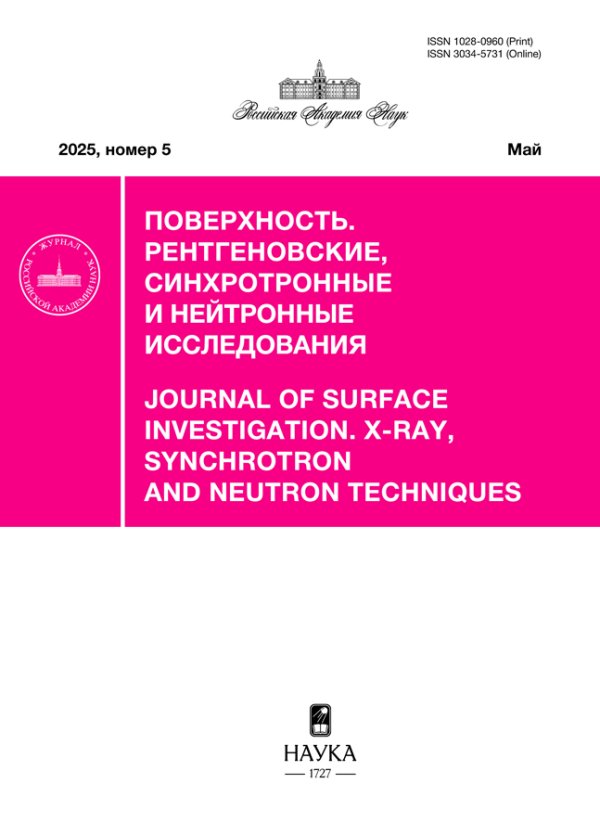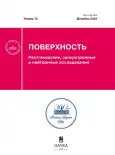Time-of-flight neutron reflectometer for compact neutron source DARIA: Monte-Carlo simulations
- Authors: Grigoryeva N.А.1, Kovalenko N.А.2,3, Grigoriev S.V.2,3
-
Affiliations:
- M.N. Mikheev Institute of Metal Physics, Ural Branch of Russian Academy of Sciences
- Saint Petersburg State University
- NRC “Kurchatov Institute”
- Issue: No 12 (2024)
- Pages: 102-117
- Section: Articles
- URL: https://journal-vniispk.ru/1028-0960/article/view/286151
- DOI: https://doi.org/10.31857/S1028096024120126
- EDN: https://elibrary.ru/QWHZQU
- ID: 286151
Cite item
Abstract
Two types of reflectometers have been simulated for the compact neutron source DARIA (Dedicated for Academical Research and Industrial Application), depending on the type of target assembly with thermal or cryogenic moderators. Modeling and optimization of reflectometers were carried out using McStas software package by Monte–Carlo method with given momentum transfer resolution Δq/q ≤ 5% for reflection angles greater than the θcr critical angle and horizontal divergence of the neutron beam of Δθ ≤ 0.1° for θ < θcr and Δθ ≤ 0.033° for θ > θcr. To reduce losses in neutrons, neutron guides with a supermirror coating have been proposed. A system of choppers makes it possible to create a neutron spectrum of the required width on a sample.
Full Text
About the authors
N. А. Grigoryeva
M.N. Mikheev Institute of Metal Physics, Ural Branch of Russian Academy of Sciences
Author for correspondence.
Email: n.a.grigorieva@yandex.ru
Russian Federation, Ekaterinburg
N. А. Kovalenko
Saint Petersburg State University; NRC “Kurchatov Institute”
Email: n.a.grigorieva@yandex.ru
Petersburg Nuclear Physics Institute named by B.P. Konstantino
Russian Federation, St. Petersburg; GatchinaS. V. Grigoriev
Saint Petersburg State University; NRC “Kurchatov Institute”
Email: n.a.grigorieva@yandex.ru
Petersburg Nuclear Physics Institute named by B.P. Konstantino
Russian Federation, St. Petersburg; GatchinaReferences
- Боднарчук В.И., Булкин А.П., Кравцов Е.А., Плешанов Н.К., Сыромятников В.Г., Ульянов В.А. // Кристаллография. 2022. Т. 67. № 1. C. 57. https://www.doi.org/10.31857/S0023476122010040
- Сыромятников В.Г., Григорьева Н.А., Григорьев С.В. // Поверхность. Рентген., синхротр. нейтрон. исслед. 2023. № 7. C. 93. https://www.doi.org/10.31857/S102809602307018X
- Grigoryeva N.A., Ukleev V., Vorobiev A.A., Stognij A.I., Novitskii N.N., Lutsev L.V., Grigoriev S.V. // Magnetochemistry. 2022. V. 8. P. 167. https://doi.org/10.3390/magnetochemistry8120167
- Кожевников С.В., Жакетов В.Д., Раду Ф. // Журнал экспериментальной и теоретической физики. 2018. Т. 154. Вып. 4 (10). С. 698. https://www.doi.org/10.1134/S0044451018100024
- Lefmann K., Nielsen N.K. // Neutron news. 1999. V. 10. № 3. P. 20. https://doi.org/10.1080/10448639908233684
- Уиндзор К. Рассеяние нейтронов от импульсных источников. М.: Энергоатомиздат, перевод с английского, 1985. 352 с.
- Плешанов Н.К. // Поверхность. Рентген., синхротр. нейтрон. исслед. 2016. № 8. C. 20. https://www.doi.org/10.7868/S0207352816080151
- Gutberlet Th., Rucker U., Zakalek P., Cronert T., Voigt J., Baggemann J., Doege P.-E., Mauerhofer E., Bohm S., Dabruck J., Nabbi R., Butzek M., Klaus M., Lange C., Bruckel T. // Physica B: Condensed Matter. 2019. V. 570. P. 345. https://doi.org/10.1016/j.physb.2018.01.019
- Hawkesworth M.R. // Atomic Energy Rev. 1977. V. 15. P. 169.
- Subbotina V.V., Pavlov K.A., Kovalenko N.A., Konik P.I., Voronin V.V., Grigoriev S.V. // Nucl. Instrum. Methods Phys. Res. A. 2021. V. 1008. P. 165462. https://doi.org/10.1016/j.nima.2021.165462
- Moroz A.R., Kovalenko N.A. // J. Surf. Invest.: X-ray, Synchrotron Neutron Tech. 2023. V. 17. No. 4. P. 799. https://www.doi.org/10.1134/S1027451023040092
- Moroz A.R., Kovalenko N.A., Grigoriev S.V. // J. Neutron Res. 2022. V. 24. P. 299. https://www.doi.org/10.3233/JNR-220025
- Булавин М.В., Мухин К.А., Рогов А.Д. // Атомная Энергия. 2024. Т. 137. № 1–2, в печати.
- Mirrotron Ltd (2024) Hungary. https://mirrotron.com/en
- Neutron Optical Components and Instruments (2024) SwissNeutronics AG, Switzerland. https://www.swissneutronics.ch/products/neutron-supermirrors/
- Плешанов Н.К., Булкин А.П., Сыромятников В.Г. // Физика твердого тела. 2010. Т. 52. № 5. С. 954. https://journals.ioffe.ru/articles/viewPDF/1835
- Grigoriev S.V., Runov V.V., Okorokov A.I. // Nucl. Instrum. Methods Phys. Res. A. 1997. V. 384. № 2–3. P. 451. https://www.doi.org/10.1016/S0168-9002(96)00919-9
- Syromyatnikov V.G., Ulyanov V.A., Lauter V., Pusenkov V.M., Ambaye H., Goyette R., Hoffmann M., Bulkin A.P., Kuznetsov I.N., Medvedev E.N. // J. Phys.: Conf. Ser. 2014. V. 528. № 1. P. 012021. https://www.doi.org/10.1088/1742-6596/528/1/012021
- Кащук А.П., Левицкая О.В. // Журнал технической физики. 2020 Т. 90. № 4. C. 519. https://www.doi.org/10.21883/JTF.2020.04.49074.84-19
- Hayter J.B., Mook H.A. // J. Appl. Cryst. 1989. V. 22. P. 35. https://doi.org/10.1107/S0021889888010003
- Schanzer C., Schneider M., Boni P. // J. Phys.: Conf. Ser. 2016. V. 746. P. 012024. https://www.doi.org/10.1088/1742-6596/746/1/ 012024
Supplementary files





























